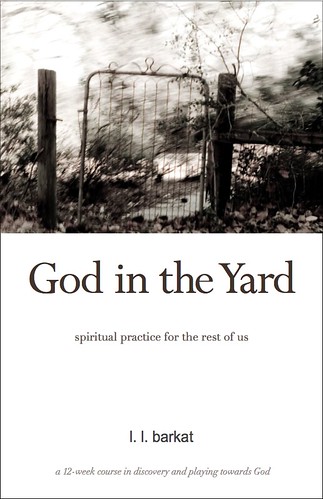Not literally, of course. I wasn’t a pint-sized Paul Bunyan, wielding my axe, toddling around with a stuffed blue ox. The woods were a place I sought solace from a difficult life. There, I watched the creek change from silver-green ribbon, to amber, from ice-blue to spring’s rush and tumble of white. I floated sticks and made pine needle beds. Sometimes I raced my sister across the creek rocks, then knocked her into the reeds. In the woods I was free.
Today, the squeal of a garbage truck wakes me three times a week. Horns and sirens break through the quiet of dawn and night. My house clings to the edge of a hill, less than a quarter of an acre in size, and a rusty chain-link fence hitches my yard to the yards of my neighbors. Three unidentified cats use my front steps to nap and my back yard to poop. My sister lives far away.
There is a part of me that feels pinched in this life—a life I freely chose when I put a distance between me and my growing-up place.
But it’s no fun to live with the pain of pinching. That is why I first returned to the woods.
________________________________________________
1. And you?
In your journal, or during a small group sharing time,
complete the thoughts:
“When I was a child, I lived…”
“Today I live...”
“If I could, I would return to...”
________________________________________________
It might be an exaggeration to call the trees in my back yard woods. A single fir spreads her arms above a patch of English ivy. Two maples reach to the sun. Wood-winged bushes and thorns tussle in the shade. This is a very small space, an “edge” if you will.
Technically an edge is where one habitat meets another—where grass gradually gives way to bushes, which gives way to trees, or vice versa. I saw this recently, on a trip south. A sign explained the vitality of these regions, “Edges are places that support a broad range of wildlife.” The bald eagle is an example of a bird who lives in the edge; he nests in tall pine trees, but he fishes in wetlands and marshes.
Culturally, we’re not trained to love edges, but might they hold something unseen, unexpected? I think about Wendell Berry’s trip to Peru, where he saw mountain farmers grow food in small, seemingly inhospitable places. He says, “For those fields hold their soil on those slopes, first of all, by being little. By being little they protect themselves against erosion, but their smallness also permits attention to be focused accurately and competently on the details.”
Smallness permits attention. The fields stay intact because they are little. Could I find something worthwhile in my little back yard? Berry seemed to suggest it was possible.
Around the time I considered his words, a friend expressed surprise that I’d never read Radical Simplicity, a book by Jim Merkel, about living with limits. Well, I was feeling limited. Not just with my tiny yard space, but also in my professional development.
An extended writing project had left me feeling oddly empty. It stirred a longing for those big woods of long ago, made me covet childhood walks and lazy afternoons of tracing sticks in the mud. It also created a sense of professional discontent. I wanted more time to focus. No more of this writing-on-the-edge-of-a-napkin! I wanted to go to exotic places to jumpstart my creativity. I needed an Annie Dillard-style trip to the Galapagos. But, quite simply, I was going nowhere.
I ordered Radical Simplicity from the library.
Saying, “I ordered,” implies some kind of control. But I have doubts. Merkel’s book arrived in my life with rather suspicious timing. This suggests there is a divine librarian who puts things on hold at the library, for people who need a particular book at a particular time.
That is just a theory.
________________________________________________
2. And you?
In your journal, or during a small group sharing time,
complete the thoughts:
“A small space I tend to overlook is…”
“In order to grow, I feel like I need...”
“If I could, I would go...”
________________________________________________
As it turned out, Merkel’s book would jumpstart a commitment I had no plans of making. I would be compelled to do what Berry said the Peruvian farmers do: focus accurately and competently on the details. The details of what? I had no idea.
The invitation was simple: find a secret spot somewhere in nature, go there for an hour every day, open your ears and eyes and fingertips and take it all in, journal if you want. Make sure the spot is within walking distance. Do it for a year.
I have children. I home educate these children. This is a great investment of energy. I am a work-at-home professional. I need space in my day to research exotic trips to the Galapagos. I don’t have time to sit with the squirrels.
Plus, the only secret spot in nature within walking distance is the edge of my yard. If my neighbors want to, they can watch me look at the clouds while they make fish sticks and pick the days’ playdoh off their kitchen tables. Maybe they will turn me in to the time-management police. And, besides, grown people don’t sit in an excuse-for-a-woods, especially not in snow or rain or blistering heat, especially not on a red plastic sled with a yellow pull rope.
That is sort of what I said to myself before I pulled a kiddie sled through the edge of a sub-zero day...
[chapter continues]







